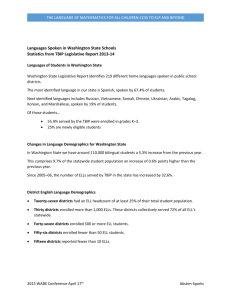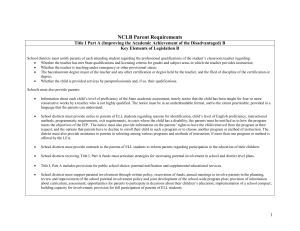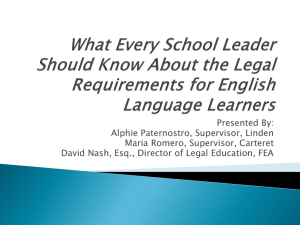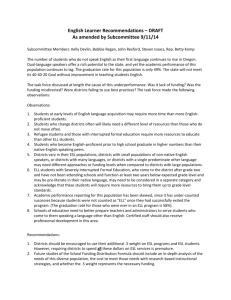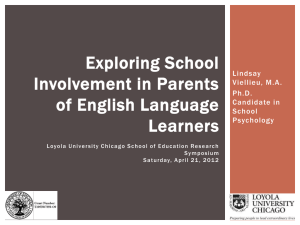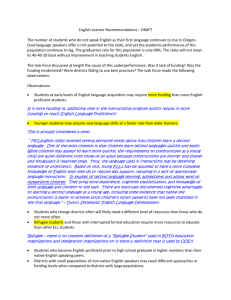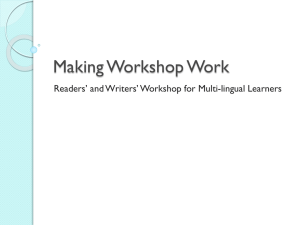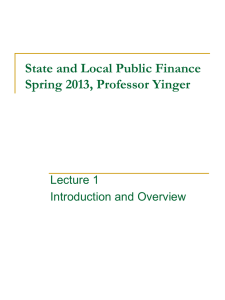Update on Implementation - Council of the Great City Schools
advertisement
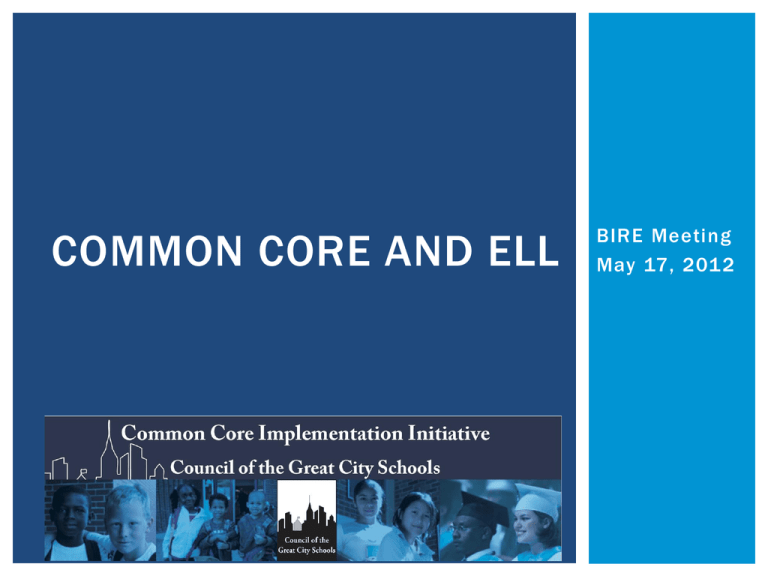
COMMON CORE AND ELL BIRE Meeting May 17, 2012 BACKGROUND Council long supporter of the Common Core State Standards Council member feedback during and since development to writers, assessment consortia, and others engaged in the work Lead district support Partnerships with the writers and lead groups Opportunity for collaboration within and across districts COLLABORATION Within a district– being at the table together from the start Across districts and states AREAS OF COUNCIL SUPPORT Strategic Communications Building Awareness and Capacity of Urban Schools Development of Tools to Implement the Standards STRATEGIC COMMUNICATIONS Parent Roadmaps in mathematics and English language arts and literacy shaped by member feedback Parent-friendly language Rationale List of most emphasized standards illustrating shifts Progression across three grade levels Questions to ask of teachers Activities to support students at home Translations in most common languages Three broadcast quality public service announcements Translation expertise, please Implementation survey Language Spanish Chinese Haitian Creole Hmong Vietnamese Cantonese Arabic Somali Tagalog/ Filipino Bengali Korean District with high District with high numbers numbers English/ Language Arts Mathematics Albuquerque* New York* Broward Chicago Boston Miami-Dade K- 5 6 - HS K- 5 6 - HS K- 5 6 - HS K- 5 6 - HS K- 5 6 - HS K- 5 6 - HS St. Paul Seattle San Francisco New York Minneapolis San Diego Fresno San Diego Oakland Hillsborough Seattle Los Angeles K- 5 6 - HS K- 5 6 - HS K- 5 6 - HS K- 5 6 - HS K- 5 6 - HS K- 5 6 - HS K- 5 6 - HS K- 5 6 - HS K- 5 6 - HS K- 5 6 - HS K- 5 6 - HS K- 5 6 - HS K- 5 6 - HS K- 5 6 - HS K- 5 6 - HS K- 5 6 - HS New York City Los Angeles CharlotteMecklenburg BUILDING AWARENESS AND CAPACIT Y Hear directly from writers of the Common Core Advisory Committees in math and ELA include representatives who lead ELL and special education in their districts Overview videos Voice of CCSS writers from Council meetings Build shared understanding Common Core strand at all conferences, including upcoming Special Conferences Basal Alignment Project Math Progressions IMPLEMENTATION TOOLS High-leverage tools Response to Intervention White Paper with examples of Tier I differentiation Update current materials to align with the standards Partner with other organizations developing tools Professional development tools Work with EL experts to extend the standards to help teachers differentiate instruction and enhance ELD Videos with facilitator guides Guidelines for professional development to share across districts Providing feedback to districts on their work PUBLISHERS’ CRITERIA THIRD REVISION, APRIL 2012 Revised based on feedback, including feedback from the ELL community achievethecore.org 1) Removed sections where the criteria went beyond the standards and intruded too much into instructional details. 2) More explicitly emphasized the important role teacher judgment plays in choosing materials. 3) Clarified that the standards require wide -ranging reading/research and reading of full novels, drama, and poems, as well as close reading of shorter texts. SO YOU WILL KNOW 4) Worked closely with the ELL community to ensure that the work on scaffolding responded to the needs of all students to gain access to high quality complex text. 5) Noted that high quality questions are usually text specific as well as text dependent; that is, that good questions are not typically generic for any text but address the specific text or texts being examined. 6) Drawing on the speaking and listening standards, noted the vibrant role of conversation between students in developing literacy. 7) Left room for a wide range of instructional approaches, while setting some basic parameters based on the standards; scaffolds do not pre-empt or replace the need to read the text, for example, the standards require that but there are many ways open for teachers to engage and students in reading. 8) More clearly articulated the central importance of the foundational skills in K -2 and the need for systematic attention to the foundations of reading. 9) Following the standards, emphasized the central role of academic vocabulary —higher level words that appear commonly in many different types of text—in reading, writing, listening and speaking. 10) Clarified several sections that were found confusing or idiosyncratic, to ensure that the criteria reflect the standards as faithfully as possible. URGENCY Tension: We have very little time (2014), but need to do this right. Tight Budgets Touch: How do we shift practices of our 434,000 teachers and our administrators for real rather than surface implementation? Test our work: Did it have an impact? How do we know? LESSONS LEARNED Be at the table Set high-leverage goals– impossible to implement everything at once Make it seamless for teachers– not separate initiative Passion counts– so does strong planning and change management
